Effect of Competent Caliche Layers on Measuring the Capacity of Axially Loaded Drilled Shafts Using the Osterberg Test
Abstract
:1. Introduction
2. Laboratory Data and Field Measurements
2.1. Laboratory Data
2.2. Field Data
2.3. Measured Pile Data
2.4. Interpretation of the Measured Full-Scale Bidirectional Osterberg Load Tests
2.4.1. O-Cell Located above and Close to the Caliche
2.4.2. O-Cell Installed between the Caliche Layers
2.4.3. O-Cell Located under and Close to the Caliche
2.4.4. O-Cell Installed under and Far from the Caliche
3. Plaxis Finite Element Analysis
3.1. Effect of O-Cell Location on the Interpretation of Test
3.2. Case Study Analyses
3.2.1. Case Study I: Caliche at the Far Location from the O-Cell
3.2.2. Case Study II: Caliche Close to O-Cell
4. Results and Discussion
5. Conclusions
Author Contributions
Funding
Conflicts of Interest
References
- Afsharhasani, R. Effect of Caliche on the Behavior of Drilled Shafts. Ph.D. Thesis, University of Nevada, Las Vegas, NV, USA, 2014. [Google Scholar]
- Kim, H.J.; Mission, J.L.; Park, T.W.; Dinoy, P.R. Analysis of Negative Skin-Friction on Single Piles by One-Dimensional Consolidation Model Test. Int. J. Civ. Eng. 2018, 16, 1445–1461. [Google Scholar] [CrossRef]
- Souza, D.T.G.; Adam, B. Load-Transfer Method for Piles under Axial Loading and Unloading. J. Geotech. Geoenviron. Eng. 2018, 144, 4017096. [Google Scholar] [CrossRef]
- Bughio, M.A.; Wang, P.; Meng, F.; Qing, C.; Kuzyakov, Y.; Wang, X.; Junejo, S.A. Neoformation of pedogenic carbonates by irrigation and fertilization and their contribution to carbon sequestration in soil. Geoderma 2016, 262, 12–19. [Google Scholar] [CrossRef]
- Hancock, G.R.; Kunkel, V.; Wells, T.; Martinez, C. Soil organic carbon and soil erosion—Understanding change at the large catchment scale. Geoderma 2019, 343, 60–71. [Google Scholar] [CrossRef]
- Brown, D.A.; Turner, J.P.; Castelli, R.J. Drilled Shafts: Construction Procedures and LRFD Design Methods; Federal Highway Administration: West Trenton, NJ, USA, 2010.
- Karakouzian, M.; Afsharhasani, R.; Kluzniak, B. Elastic analysis of drilled shaft foundations in soil profiles with intermediate caliche layers. Geotech. Spec. Publ. 2015, 256, 922–928. [Google Scholar]
- Pearthree, P.A. Geologic Excursions in Southwestern North America; Geological Society of America: Boulder, CO, USA, 2019. [Google Scholar]
- Fellenius, B.H.; Ann, T.S. Combination of O-cell Test and Conventional Head-Down Test. In Proceedings of the Art of Foundation Engineering Practice Congress 2010, West Palm Beach, FL, USA, 20–24 February 2010; Hussein, M.H., Anderson, J.B., Camp, W.M., Eds.; ASCE: Reston, VA, USA, 2010; pp. 240–259. [Google Scholar]
- Tehrani, F.S.; Salgado, R.; Prezzi, M. Analysis of axial loading of pile groups in multilayered elastic soil. Int. J. Geomech. 2016, 16, 04015063. [Google Scholar] [CrossRef]
- Pearlman, S.L. Pin Piles for Structural Underpinning. In Proceedings of the Ohio River Val Soils Semin XXXII Louisville, Louisville, KY, USA, 13 November 2001; pp. 2–12. [Google Scholar]
- Satvati, S.; Rowshanzamir, M.; Hejazi, M. Evaluation of the bearing capacity of shallow footing on soil slope reinforced by braid elements. In Proceedings of the 3rd Pan-American Conference on Geosynthetics, Miami, FL, USA, 10 April 2016. [Google Scholar]
- Farhangi, V.; Karakouzian, M.; Geertsema, M. Effect of micropiles on clean sand liquefaction risk based on CPT and SPT. Appl. Sci. 2020, 10, 3111. [Google Scholar] [CrossRef]
- Farhangi, V.; Karakouzian, M. Design of Bridge Foundations Using Reinforced Micropiles. In Proceedings of the International Road Federation Global R2T Conference & Expo, Las Vegas, NV, USA, 19–22 November 2019; pp. 78–83. [Google Scholar]
- Choi, W.; Kim, G.; Kim, I.; Kyung, D.; Lee, J. Compressive Load-Carrying Behavior of Inclined Micropiles Installed in Soil and Rock Layers. Int. J. Geomech. 2020, 20, 04020147. [Google Scholar] [CrossRef]
- Jafari, K.; Tabatabaeian, M.; Joshaghani, A.; Ozbakkaloglu, T. Optimizing the mixture design of polymer concrete: An experimental investigation. Constr. Build. Mater. 2018, 167, 185–196. [Google Scholar] [CrossRef]
- Farhangi, V.; Karakouzian, M. Effect of fiber reinforced polymer tubes filled with recycled materials and concrete on structural capacity of pile foundations. Appl. Sci. 2020, 10, 1554. [Google Scholar] [CrossRef] [Green Version]
- Haberfield, C.M.; Lochaden, A.L.E. Analysis and design of axially loaded piles in rock. J. Rock Mech. Geotech. Eng. 2019, 11, 535–548. [Google Scholar] [CrossRef]
- Toghroli, A.; Mehrabi, P.; Shariati, M.; Trung, N.T.; Jahandari, S.; Rasekh, H. Evaluating the use of recycled concrete aggregate and pozzolanic additives in fiber-reinforced pervious concrete with industrial and recycled fibers. Constr. Build. Mater. 2020, 252, 118997. [Google Scholar] [CrossRef]
- Jarrah, M.; Najafabadi, E.P.; Khaneghahi, M.H.; Oskouei, A.V. The effect of elevated temperatures on the tensile performance of GFRP and CFRP sheets. Constr. Build. Mater. 2018, 190, 38–52. [Google Scholar] [CrossRef]
- Jahandari, S.; Saberian, M.; Tao, Z.; Mojtahedi, S.F.F.; Li, J.; Ghasemi, M.; Rezvani, S.; Li, W. Effects of saturation degrees, freezing-thawing, and curing on geotechnical properties of lime and lime-cement concretes. Cold Reg. Sci. Technol. 2019, 160, 242–251. [Google Scholar] [CrossRef]
- Akbarzadeh Bengar, H.; Shahmansouri, A.A. A new anchorage system for CFRP strips in externally strengthened RC continuous beams. J. Build. Eng. 2020, 30, 101230. [Google Scholar] [CrossRef]
- Jafari, K.; Toufigh, V. Experimental and analytical evaluation of rubberized polymer concrete. Constr. Build. Mater. 2017, 155, 495–510. [Google Scholar] [CrossRef]
- Jazaei, R.; Karakouzian, M.; O’Toole, B.; Moon, J.; Gharehdaghi, S. Failure mechanism of cementitious nanocomposites reinforced by multi-walled and single-walled carbon nanotubes under splitting tensile test. In Proceedings of the ASME 2018 International Mechanical Engineering Congress and Exposition, Pittsburgh, PA, USA, 9–15 November 2018. [Google Scholar]
- Sabzi, J.; Esfahani, M.R.; Ozbakkaloglu, T.; Farahi, B. Effect of concrete strength and longitudinal reinforcement arrangement on the performance of reinforced concrete beams strengthened using EBR and EBROG methods. Eng. Struct. 2020, 205, 110072. [Google Scholar] [CrossRef]
- Satvati, S.; Nahvi, A.; Cetin, B.; Ashlock, J.C.; Jahren, C.T.; Ceylan, H. Performance-based economic analysis to find the sustainable aggregate option for a granular roadway. Transp. Geotech. 2020, 100410. [Google Scholar] [CrossRef]
- Gu, L.; Wang, Z.; Huang, Q.; Ye, G.; Zhang, F. Numerical investigation into ground treatment to mitigate the permanent train-induced deformation of pile-raft-soft soil system. Transp. Geotech. 2020, 24. [Google Scholar] [CrossRef]
- Kazemi, M.; Hajforoush, M.; Talebi, P.K.; Daneshfar, M.; Shokrgozar, A.; Jahandari, S.; Saberian, M.; Li, J. In-situ strength estimation of polypropylene fibre reinforced recycled aggregate concrete using Schmidt rebound hammer and point load test. J. Sustain. Cem. Mater. 2020, 160, 343–356. [Google Scholar] [CrossRef]
- Asem, P. Load-displacement response of drilled shaft tip in soft rocks of sedimentary origin. Soils Found. 2019, 59, 1193–1212. [Google Scholar] [CrossRef]
- Berisavljević, D.; Filipović, V.; Stanisavljević, N.; Berisavljević, Z. Experimental analysis of bi-directional pile static load test. Ce/Papers 2018, 2, 415–420. [Google Scholar] [CrossRef]
- Bohn, C.; Lopes dos Santos, A.; Frank, R. Development of axial pile load transfer curves based on instrumented load tests. J. Geotech. Geoenviron. Eng. 2017, 143, 04016081. [Google Scholar] [CrossRef]
- Li, Y.; Zhu, X.; Chen, L.; Zhou, T. Load Transfer Calculation and Analysis of Large-Diameter Bored Piles According to Rules Based on Test Pile Measurement. J. Highw. Transp. Res. Dev. 2018, 12, 28–36. [Google Scholar] [CrossRef]
- Seo, H.; Moghaddam, R.B.; Lawson, W.D. Assessment of methods for construction of an equivalent top loading curve from O-cell test data. Soils Found. 2016, 56, 889–903. [Google Scholar] [CrossRef]
- Asem, P.; Gardoni, P. A load-transfer function for the side resistance of drilled shafts in soft rock. Soils Found. 2019, 59, 1241–1259. [Google Scholar] [CrossRef]
- Ng, T.T.; Meyers, R. Side resistance of drilled shafts in granular soils investigated by DEM. Comput. Geotech. 2015, 68, 161–168. [Google Scholar] [CrossRef]
- Zhou, Z.; Dong, Y.; Jiang, P.; Han, D.; Liu, T. Calculation of Pile Side Friction by Multiparameter Statistical Analysis. Adv. Civ. Eng. 2019, 2019, 2638520. [Google Scholar] [CrossRef]
- Zhou, J.; Zhou, C.; Feng, Q.; Gao, T. Analytical Model for Load-Transfer Mechanism of Rock-Socketed Drilled Piles: Considering Bond Strength of the Concrete-Rock Interface. Int. J. Geomech. 2020, 20. [Google Scholar] [CrossRef]
- ASTM. Standard Test Methods for Deep Foundations under Static Axial Compressive Load, 8th ed.; Astm D1143/D1143M-07, American Society for Testing and Materials, Annual Book of ASTM Standards; ASTM International: West Conshohocken, PA, USA, 2013. [Google Scholar]
- Xu, M.; Ni, P.; Mei, G.; Zhao, Y. Load-settlement behaviour of bored piles with loose sediments at the pile tip: Experimental, numerical and analytical study. Comput. Geotech. 2018, 102, 92–101. [Google Scholar] [CrossRef]
- DD3550M ASTM, Standard Practice for Thick Wall, Ring-Lined, Split Barrel, Drive Sampling of Soils; ASTM: West Conshohocken, PA, USA, 2017.
- ASTM D4318-00, Standard Test Methods for Liquid Limit, Plastic Limit, and Plasticity Index of Soils; ASTM: West Conshohocken, PA, USA, 2018.
- ASTM D3080, Standard Test Method for Direct Shear Test of Soils under Consolidated Drained Conditions; ASTM: West Conshohocken, PA, USA, 2011.
- Abedin, M.; Mehrabi, A.B. Novel approaches for fracture detection in steel girder bridges. Infrastructures 2019, 4, 42. [Google Scholar] [CrossRef] [Green Version]
- Valikhani, A.; Jahromi, A.J.; Mantawy, I.M.; Azizinamini, A. Numerical modelling of concrete-to-UHPC bond strength. Materials 2020, 13, 1379. [Google Scholar] [CrossRef] [Green Version]
- Boushehri, R.; Estahbanati, S.H.; Hosseini, S.M.M.M.; Soroush, A. Influence of Reinforcement Parameters on the Seismic Response of Reinforced Earth Dams. In Proceedings of the Geo-Congress 2020: Engineering, Monitoring, and Management of Geotechnical Infrastructure, Minneapolis, MN, USA, 25–28 February 2020; pp. 637–649. [Google Scholar]
- Estahbanati, S.H.; Boushehri, R.; Soroush, A.; Ghasemi-Fare, O. Numerical study of the effects of deep excavations on dynamic performance of buried pipelines. In Proceedings of the Geo-Congress 2020: Engineering, Monitoring, and Management of Geotechnical Infrastructure, Minneapolis, MN, USA, 25–28 February 2020; pp. 86–94. [Google Scholar]
- Osterberg, J.; Pepper, S. A new simplified method for load testing drilled shafts. Found Drill. 1984, 23, 9–11. [Google Scholar]
- Asem, P. The effect of expansive concrete on the side resistance of sockets in weak rock. Soils Found. 2020, 60, 274–282. [Google Scholar] [CrossRef]
- Plaxis, B. PLAXIS 2D Version 8.2-Finite Element Code for Soil and Rock Analysis; AA Balkema: Delft, The Netherlands, 2004. [Google Scholar]
- Asgharzadeh, A.; Nazari Tiji, S.A.; Esmaeilpour, R.; Park, T.; Pourboghrat, F. Determination of hardness-strength and -flow behavior relationships in bulged aluminum alloys and verification by FE analysis on Rockwell hardness test. Int. J. Adv. Manuf. Technol. 2020, 106, 315–331. [Google Scholar] [CrossRef]
- Zamanian, S.; Hur, J.; Shafieezadeh, A. Significant variables for leakage and collapse of buried concrete sewer pipes: A global sensitivity analysis via Bayesian additive regression trees and Sobol’ indices. Struct. Infrastruct. Eng. 2020. [Google Scholar] [CrossRef]
- Beizaei, M.; Hosseininia, E.S.; Morovatdar, A. Investigating the Practical Conditions to Utilize Brick Stair Wall Method as a Supporting Structure in Urban Excavation. In Proceedings of the Geo-Congress 2020: Engineering, Monitoring, and Management of Geotechnical Infrastructure, Minneapolis, MN, USA, 25–28 February 2020; pp. 429–439. [Google Scholar]
- Eslami, M.; Namba, H. Elasto-plastic behavior of composite beam connected to RHS column, experimental test results. Int. J. Steel Struct. 2016, 16, 901–912. [Google Scholar] [CrossRef]
- Liang, J.; Nie, X.; Masud, M.; Li, J.; Mo, Y.L. A study on the simulation method for fatigue damage behavior of reinforced concrete structures. Eng. Struct. 2017, 150, 25–38. [Google Scholar] [CrossRef]
- Dehghani, N.L.; Rahimi, M.; Shafieezadeh, A.; Padgett, J.E. Parameter Estimation of a Fractional Order Soil Constitutive Model Using KiK-Net Downhole Array Data: A Bayesian Updating Approach. Geotech. Spec. Publ. 2020, 2020, 346–356. [Google Scholar]

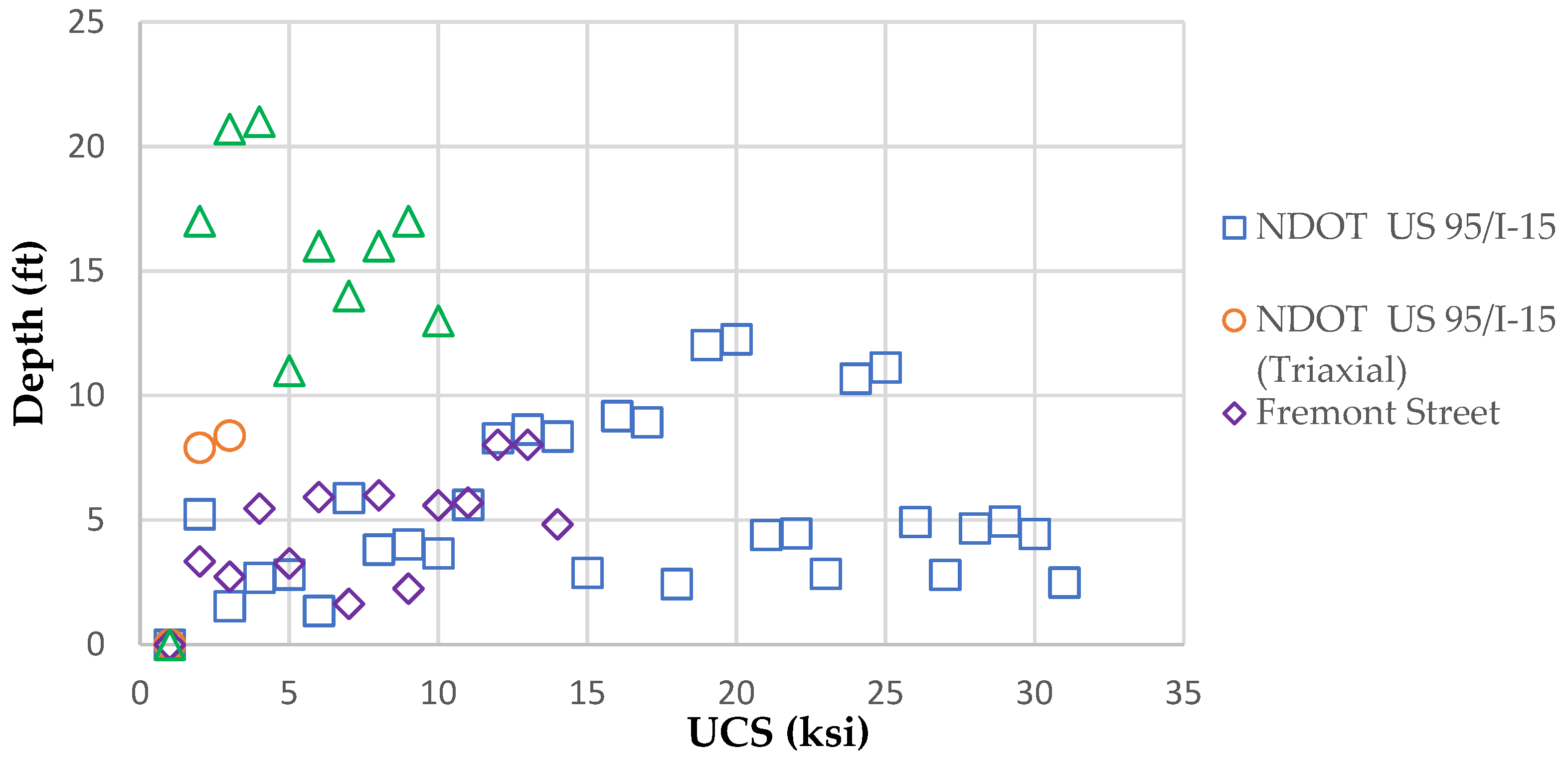



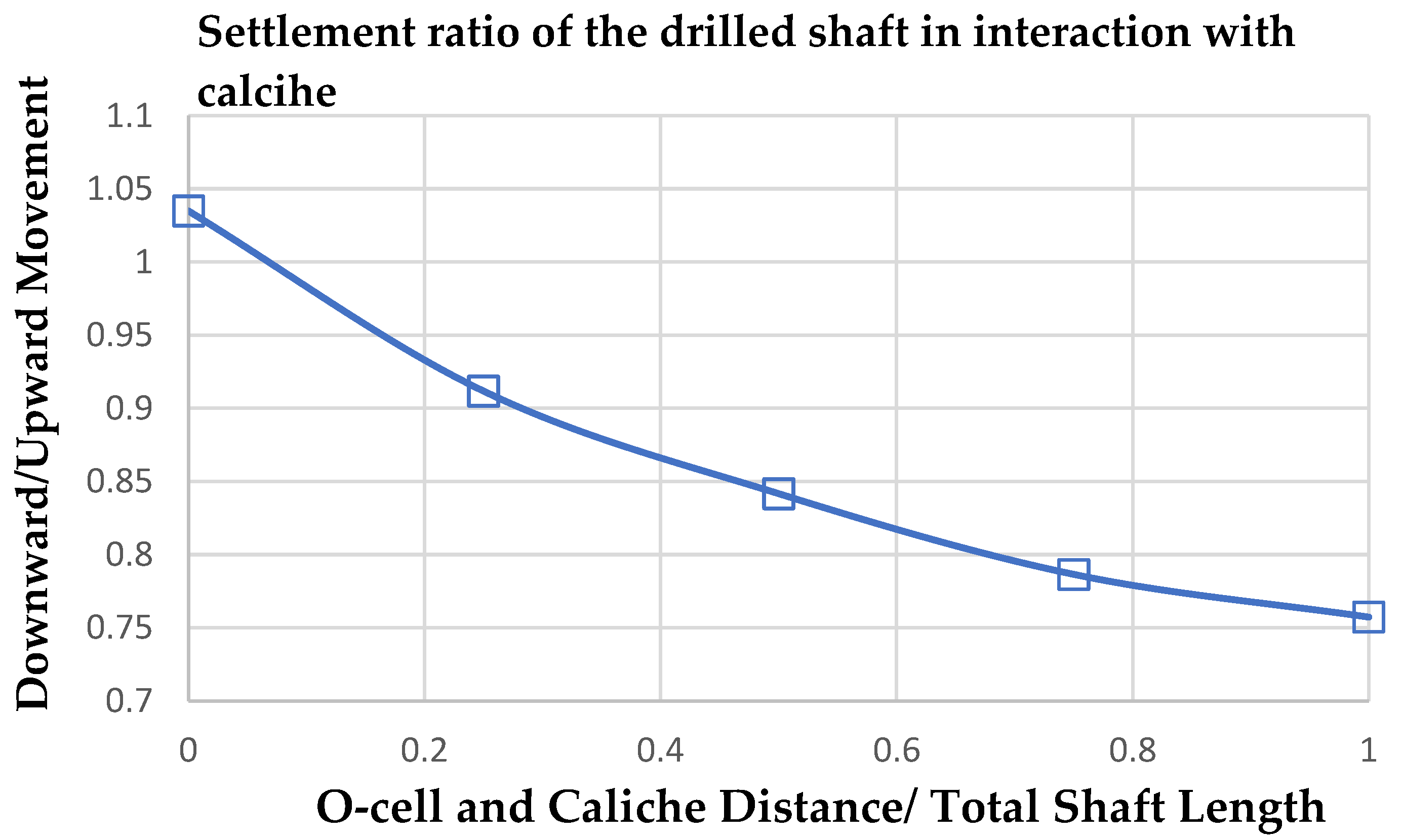
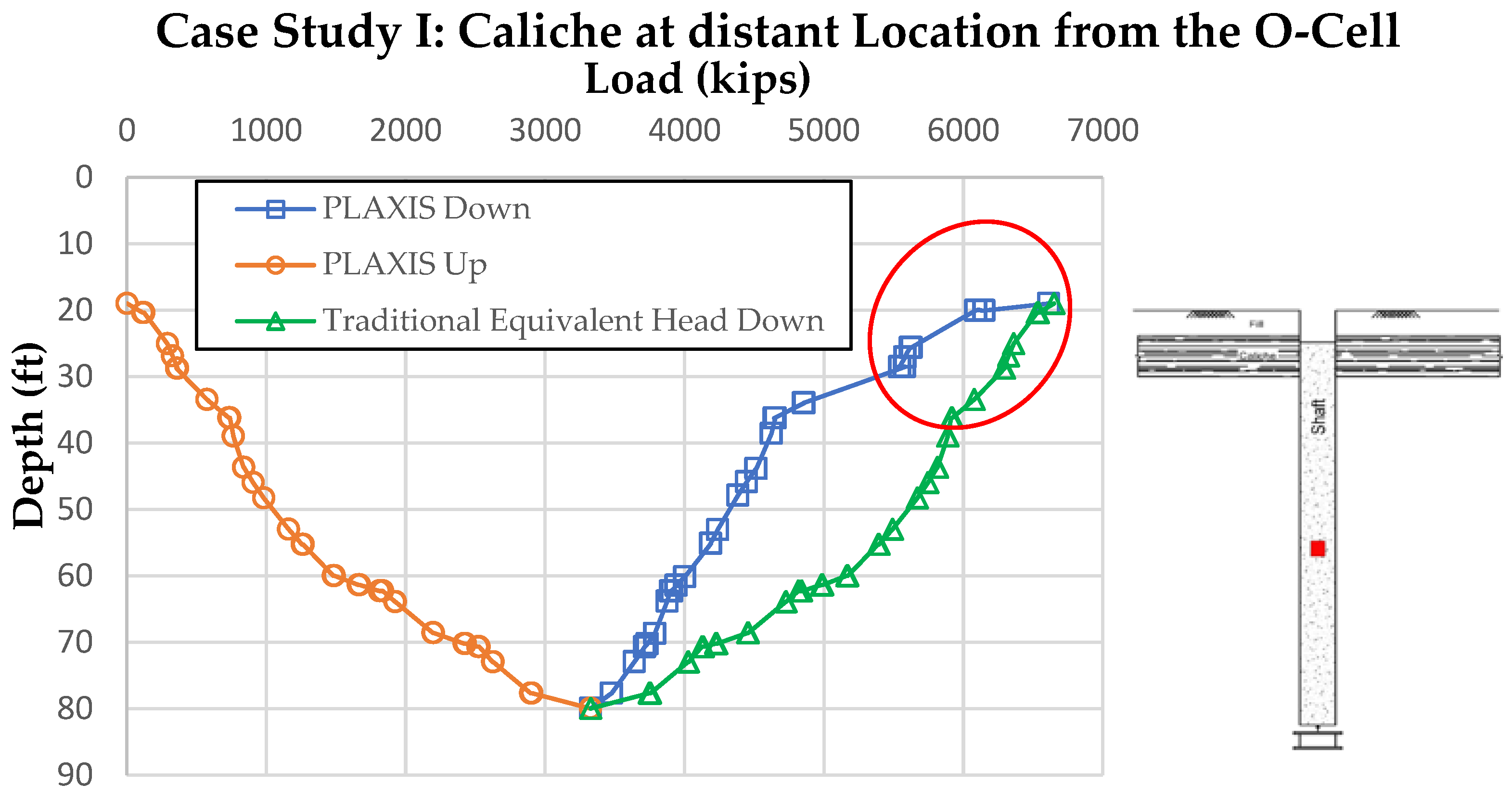

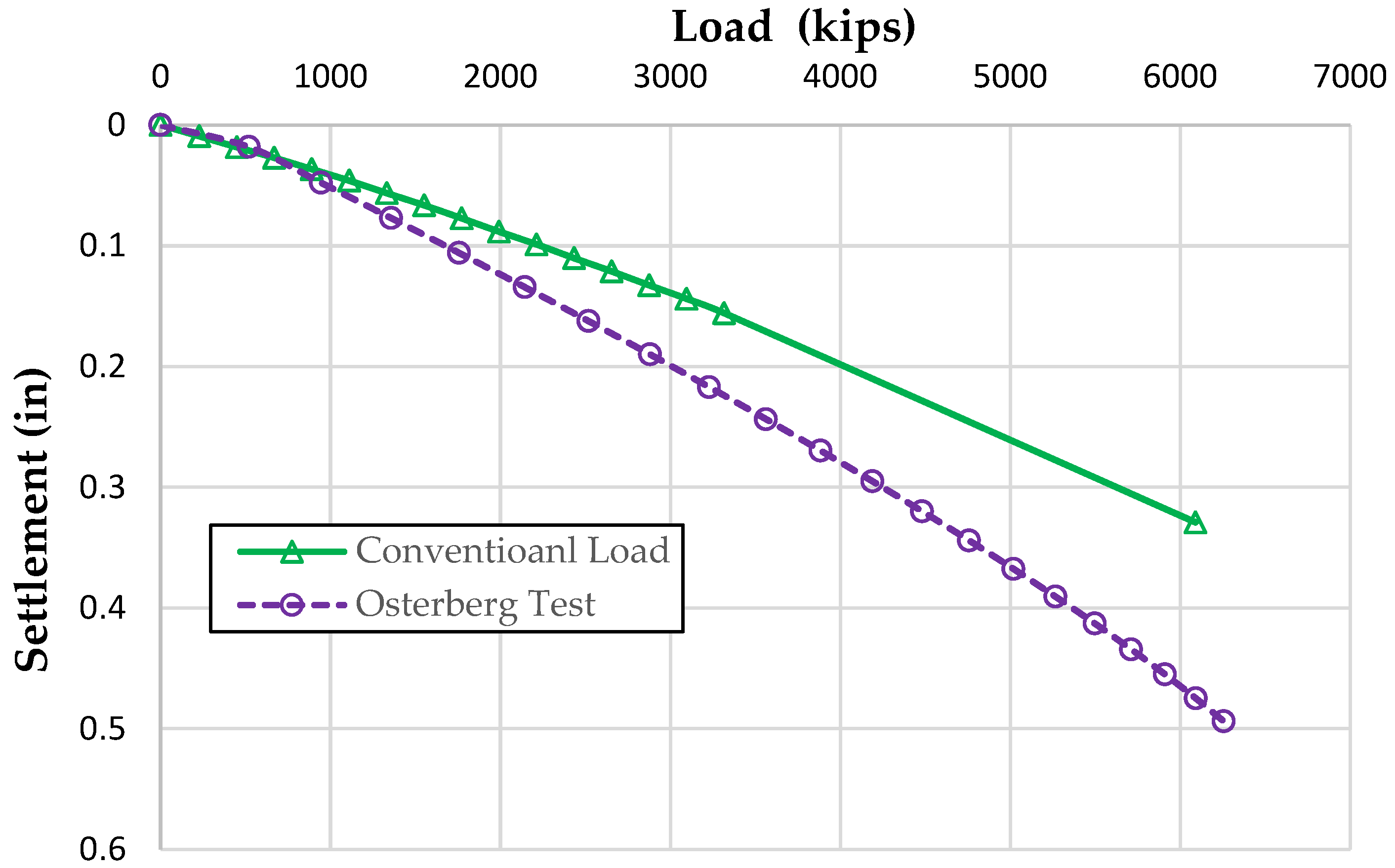
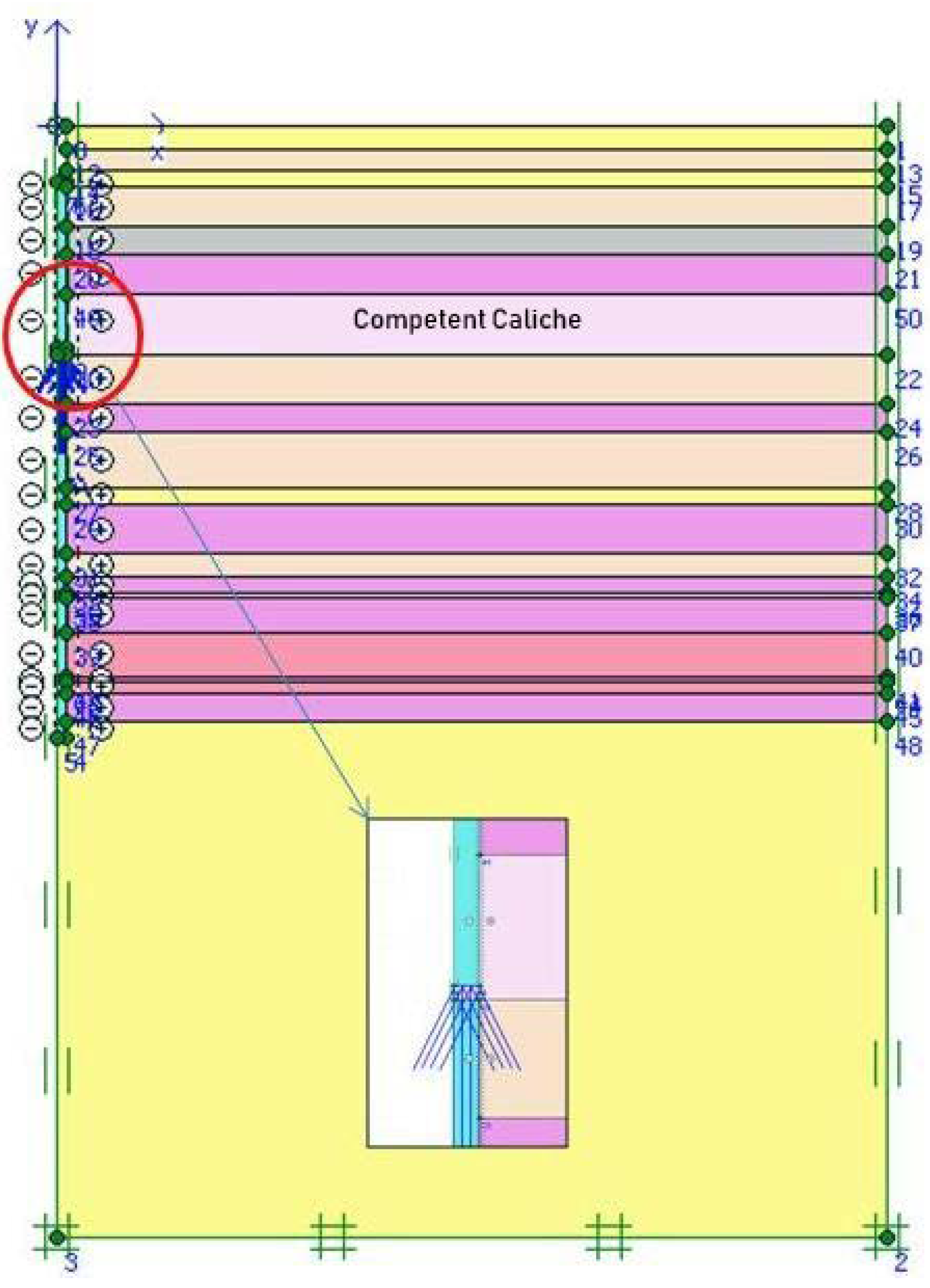
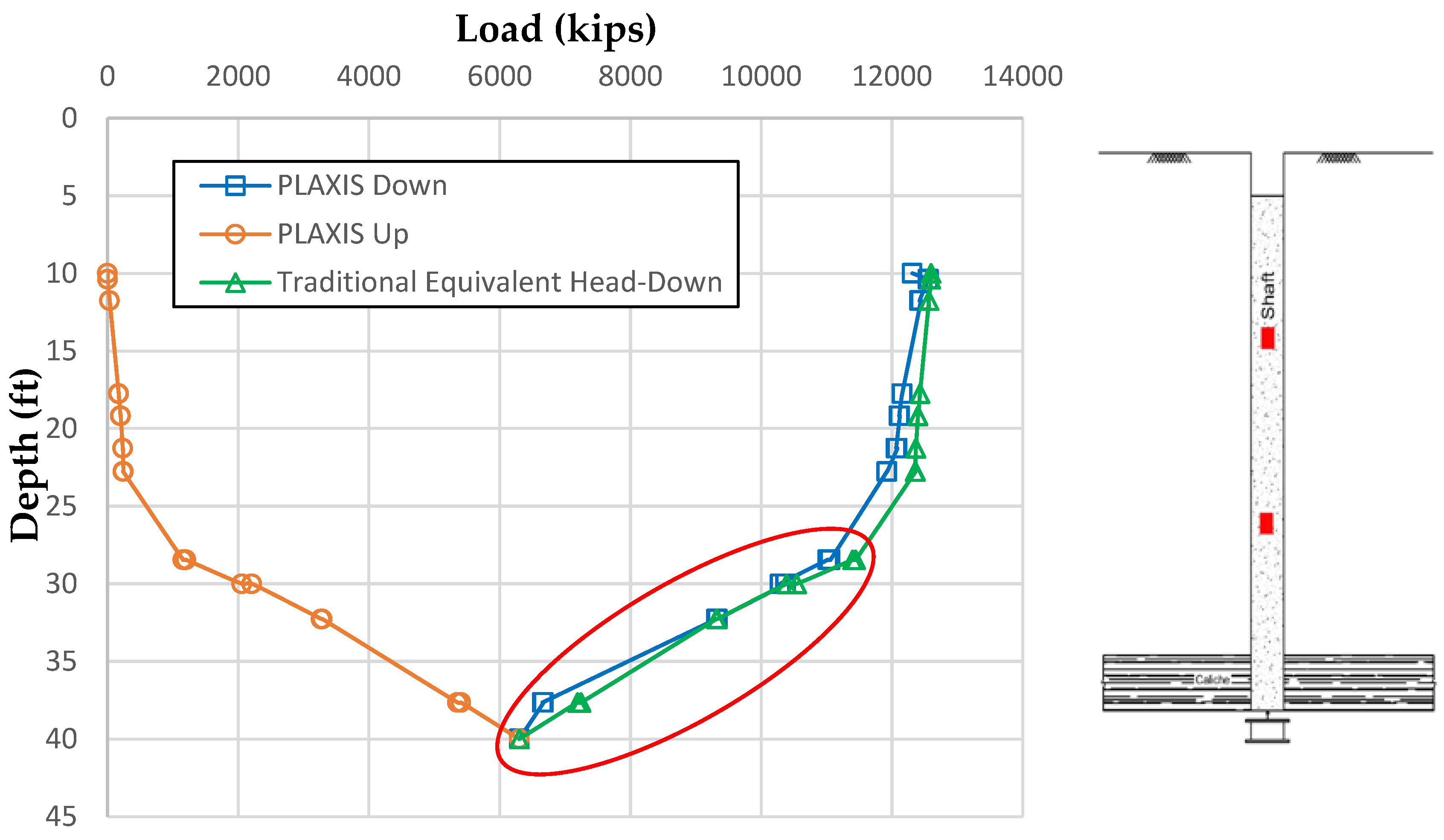


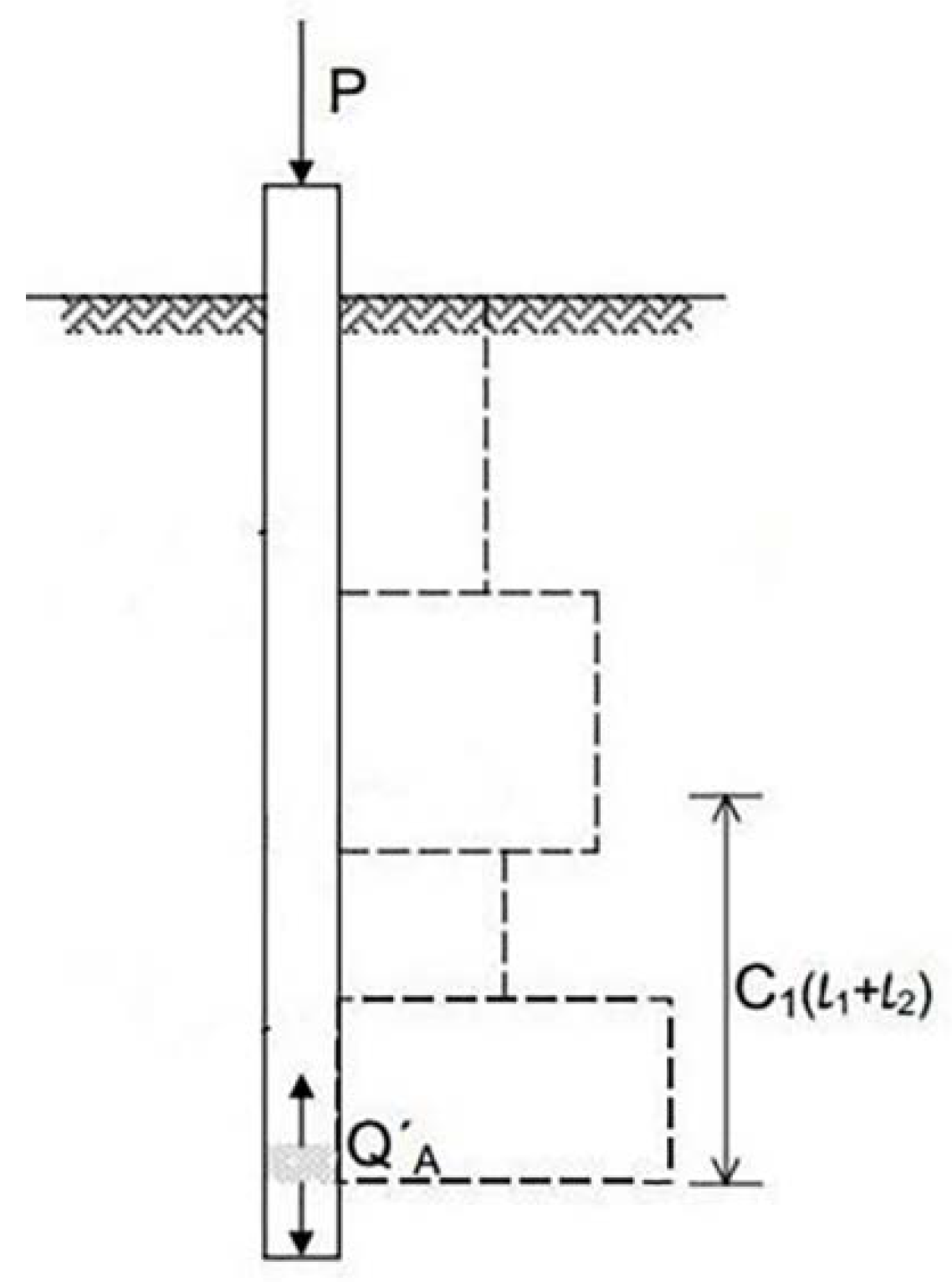

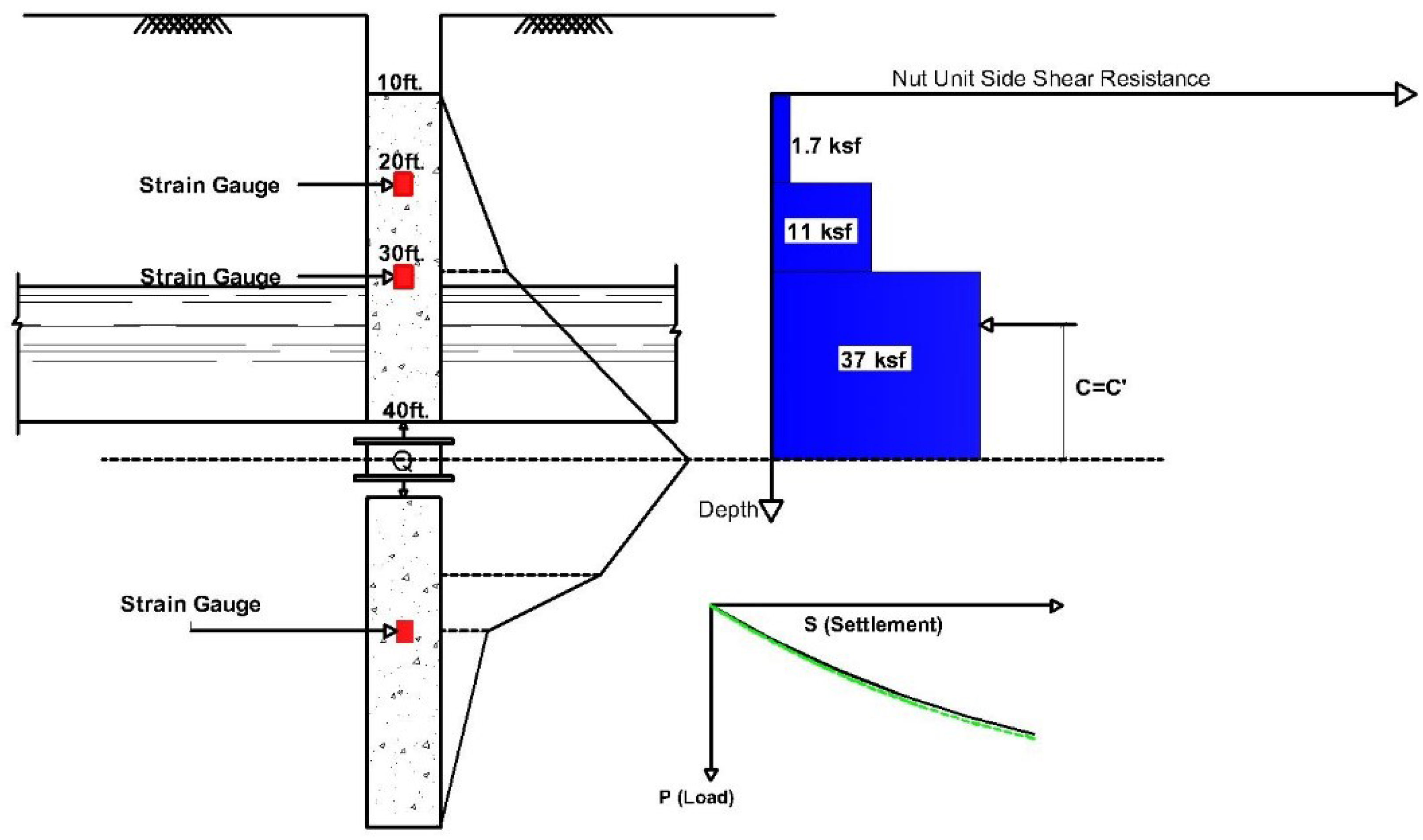
| Test ID | (Caliche Depth *, Caliche Thickness) (ft) | Shaft Diameter (in) | Shaft Length (ft) | O-Cell Installation Depth (ft) | Top of the Shaft (ft) | Maximum O-Cell Load (kips) |
|---|---|---|---|---|---|---|
| TP-1 | (18, 3), (24, 10), (39, 3), (47, 6) | 48 | 106 | 50 | 20 | 6748 |
| TP-2 | (21, 15), (42, 6), (53, 3), (61, 8), (77, 8) | 48 | 105 | 35 | 5 | 3964 |
| TP-3 | (11, 8), (33, 3), (44, 7) | 48 | 117 | 60 | 5 | 4722 |
| TP-4 | (14, 6), (54, 2), (66, 1) | 48 | 112 | 60 | 9 | 4287 |
| TP-5 | (13, 7), (31, 4), (71, 4) | 48 | 97 | 39 | 14 | 7086 |
| TP-6,7,8 | (23, 7), (34, 5), (56, 3) | 48 | 128 | 43 | 0 | 5476 |
| TP-9,10 | (8, 1), (11, 1), (13, 4), (21, 1), (29, 1) | 48 | 122 | 80,120 | 45 | 3077 |
| TP-11 | (30, 10), (55, 8) | 36 | 100 | 55 | 30 | 1959 |
| TP-12 | (29, 7), (55, 4), (66, 7), (90, 3), (123, 4), (146, 4) | 48 | 100 | 50 | 40 | 3544 |
| TP-13 | (12, 6), (26, 8), (51, 4), (126, 4) | 48 | 99 | 45 | 30 | 3684 |
| TP-14 | (12, 6), (26, 8), (51, 4), (126, 4) | 48 | 99 | 45 | 30 | 5950 |
| TP-15 | (8, 1), (40, 1), (43, 2) | 48 | 123 | 78 | 12 | 6164 |
| TP-16 | (36, 51), (51, 1), (60, 2) | 48 | 123 | 65 | 10 | 6172 |
| TP-17 | (23, 18), (50, 5), (68, 9) | 42 | 100 | 40 | 10 | 6128 |
| TP-18 | (10, 1), (13, 1), (52, 4), (65, 4) | 48 | 62 | 57 | 8 | 3068 |
| TP-19 | (13, 4), (30, 6), (60, 2), (69, 1) | 48 | 103 | 50,80 | 19 | 3316 |
| TP-20 | (18, 16), (36, 16), (92, 4) | 42 | 90 | 35 | 10 | 7358 |
| TP-21 | (6, 14) | 42 | 74 | 30 | 15 | 6400 |
| TP-22 | (5, 12) | 48 | 96 | 80 | 15 | 4800 |
| TP-23 | (6, 10) | 48 | 100 | 54 | 14 | 7202 |
| TP-24 | (4, 5) | 43 | 91 | 42 | 8 | 2901 |
| TP-25 | (6, 1), (16, 1) | 41 | 90 | 50 | 0 | 4098 |
| TP-26 | (7, 2) | 36 | 79 | 41 | 1 | 3133 |
| TP-27 | (6, 6), (27, 3), (45, 4) | 42 | 70 | 35 | 10 | 4088 |
| TP-28 | (25, 2) | 42 | 73 | 27 | 4 | 4914 |
| TP-29 | (14, 2), (17, 2), (25, 2), (28, 1), (31, 2), (50, 1), (70, 1) | 45 | 104 | 40 | 10 | 6400 |
| TP-30 | (19, 2), (35, 3), (55, 7) | 42 | 90 | 50 | 15 | 2978 |
| Material Properties of Sensitivity Case Study I | ||||
| Parameter | Unit | Concrete | Sandy Clay | Caliche |
| Material Model | Linear Elastic | MC | MC | |
| Drainage condition | Drained | Drained | Drained | |
| Dry Unit Weight | klb/ft3 | 0.15 | 0.12 | 0.16 |
| Saturated Unit Weight | klb/ft3 | 0.15 | 0.13 | 0.16 |
| Young’s Modulus | klb/ft2 | 500,000 | 4000 | 280,000 |
| Poisson’s ratio | 0.15 | 0.3 | 0.2 | |
| Cohesion | klb/ft2 | - | 1 | 10 |
| Friction Angle | Degree | - | 28 | 35 |
| Interface Material | ||||
| Material Model | Unit | MC | MC | |
| Drainage condition | Drained | Drained | ||
| Dry Unit Weight | klb/ft3 | 0.12 | 0.16 | |
| Saturated Unit Weight | klb/ft3 | 0.13 | 0.16 | |
| Young’s Modulus | klb/ft2 | 4000 | 280,000 | |
| Poisson’s ratio | 0.3 | 0.2 | ||
| Cohesion | klb/ft2 | 0.3 | 10 | |
| Friction Angle | Degree | 23 | 35 | |
| Material Properties of Sensitivity Case Study II | |||||||
| Parameter | Unit | Concrete | Clayey Sand | Sandy Clay | Cemented Sand and Gravel | Caliche | Stiff Clay |
| Material Model | Linear Elastic | MC | MC | MC | MC | MC | |
| Drainage condition | Drained | Drained | Drained | Drained | Drained | Drained | |
| Dry Unit Weight | klb/ft3 | 0.15 | 0.12 | 0.12 | 0.12 | 0.16 | 0.13 |
| Saturated Unit Weight | klb/ft3 | 0.15 | 0.12 | 0.13 | 0.13 | 0.16 | 0.13 |
| Young’s Modulus | klb/ft2 | 445,600 | 1000 | 1500 | 3000 | 560,000 | 1000 |
| Poisson’s ratio | 0.15 | 0.3 | 0.3 | 0.3 | 0.2 | 0.4 | |
| Cohesion | klb/ft2 | - | 0.8 | 1 | 0.1 | 20 | 0.2 |
| Friction Angle | Degree | - | 35 | 28 | 45 | 35 | 30 |
| Interface Material | |||||||
| Material Model | Unit | MC | MC | MC | M | MC | |
| Drainage condition | Drained | Drained | Drained | Drained | Drained | ||
| Dry Unit Weight | klb/ft3 | 0.12 | 0.12 | 0.12 | 0.16 | 0.13 | |
| Saturated Unit Weight | klb/ft3 | 0.12 | 0.13 | 0.13 | 0.16 | 0.13 | |
| Young’s Modulus | klb/ft2 | 1000 | 1500 | 3000 | 560,000 | 1000 | |
| Poisson’s ratio | 0.3 | 0.3 | 0.3 | 0.2 | 0.4 | ||
| Cohesion | klb/ft2 | 0.8 | 1 | 0.1 | 20 | 0.2 | |
| Friction Angle | Degree | 22 | 23 | 30 | 28 | 18 | |
© 2020 by the authors. Licensee MDPI, Basel, Switzerland. This article is an open access article distributed under the terms and conditions of the Creative Commons Attribution (CC BY) license (http://creativecommons.org/licenses/by/4.0/).
Share and Cite
Afsharhasani, R.; Karakouzian, M.; Farhangi, V. Effect of Competent Caliche Layers on Measuring the Capacity of Axially Loaded Drilled Shafts Using the Osterberg Test. Appl. Sci. 2020, 10, 6169. https://doi.org/10.3390/app10186169
Afsharhasani R, Karakouzian M, Farhangi V. Effect of Competent Caliche Layers on Measuring the Capacity of Axially Loaded Drilled Shafts Using the Osterberg Test. Applied Sciences. 2020; 10(18):6169. https://doi.org/10.3390/app10186169
Chicago/Turabian StyleAfsharhasani, Rouzbeh, Moses Karakouzian, and Visar Farhangi. 2020. "Effect of Competent Caliche Layers on Measuring the Capacity of Axially Loaded Drilled Shafts Using the Osterberg Test" Applied Sciences 10, no. 18: 6169. https://doi.org/10.3390/app10186169
APA StyleAfsharhasani, R., Karakouzian, M., & Farhangi, V. (2020). Effect of Competent Caliche Layers on Measuring the Capacity of Axially Loaded Drilled Shafts Using the Osterberg Test. Applied Sciences, 10(18), 6169. https://doi.org/10.3390/app10186169






